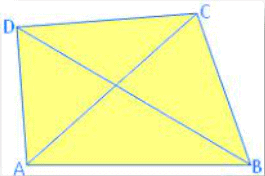Class 9 Exam > Class 9 Questions > Direction: In each of the following question...
Start Learning for Free
Direction: In each of the following questions, a statement of Assertion is given followed by a corresponding statement of Reason just below it. Of the statements, mark the correct.
Assertion : The consecutive sides of a quadrilateral have one common point.
Reason : The opposite sides of a quadrilateral have two common point.
- a)Assertion and reason are true and reason is the correct explanation of assertion.
- b)Both assertion and reason are true but reason is not the correct explanation of assertion.
- c)Assertion is true but reason is false.
- d)Assertion is false but reason is true.
Correct answer is option 'C'. Can you explain this answer?
| FREE This question is part of | Download PDF Attempt this Test |
Verified Answer
Direction: In each of the following questions, a statement of Asserti...

Two sides of a quadrilateral are called its opposite sides if they do not have a common end point.
In the given figure, (AB, DC) and (AD, BC) are two pairs of opposite sides of quadrilateral ABCD.
Two angles of a quadrilateral having a common arm are called its adjacent angles.
Most Upvoted Answer
Direction: In each of the following questions, a statement of Asserti...
Assertion : The consecutive sides of a quadrilateral have one common point.
Reason : The opposite sides of a quadrilateral have two common points.
The correct answer is option C, which states that the assertion is true but the reason is false.
Explanation:
- A quadrilateral is a polygon with four sides. The sides of a quadrilateral can be categorized into consecutive sides and opposite sides.
- Consecutive sides of a quadrilateral are those sides that are adjacent to each other, meaning they share a common endpoint or vertex.
- For example, in a quadrilateral ABCD, the consecutive sides are AB, BC, CD, and DA.
- The assertion states that the consecutive sides of a quadrilateral have one common point. This is true because consecutive sides share a common vertex.
- However, the reason states that the opposite sides of a quadrilateral have two common points. This is not true. Opposite sides of a quadrilateral do not necessarily have two common points.
- Opposite sides of a quadrilateral are the sides that are not adjacent to each other. For example, in quadrilateral ABCD, the opposite sides are AB and CD, as well as BC and DA.
- Opposite sides may or may not intersect each other. In some quadrilaterals, the opposite sides may be parallel and never intersect. In others, the opposite sides may intersect at a single point.
- Therefore, the reason given is incorrect as it generalizes that the opposite sides of a quadrilateral always have two common points, which is not true.
In conclusion, the assertion that the consecutive sides of a quadrilateral have one common point is true. However, the reason that the opposite sides of a quadrilateral have two common points is false. Therefore, option C is the correct answer.
Reason : The opposite sides of a quadrilateral have two common points.
The correct answer is option C, which states that the assertion is true but the reason is false.
Explanation:
- A quadrilateral is a polygon with four sides. The sides of a quadrilateral can be categorized into consecutive sides and opposite sides.
- Consecutive sides of a quadrilateral are those sides that are adjacent to each other, meaning they share a common endpoint or vertex.
- For example, in a quadrilateral ABCD, the consecutive sides are AB, BC, CD, and DA.
- The assertion states that the consecutive sides of a quadrilateral have one common point. This is true because consecutive sides share a common vertex.
- However, the reason states that the opposite sides of a quadrilateral have two common points. This is not true. Opposite sides of a quadrilateral do not necessarily have two common points.
- Opposite sides of a quadrilateral are the sides that are not adjacent to each other. For example, in quadrilateral ABCD, the opposite sides are AB and CD, as well as BC and DA.
- Opposite sides may or may not intersect each other. In some quadrilaterals, the opposite sides may be parallel and never intersect. In others, the opposite sides may intersect at a single point.
- Therefore, the reason given is incorrect as it generalizes that the opposite sides of a quadrilateral always have two common points, which is not true.
In conclusion, the assertion that the consecutive sides of a quadrilateral have one common point is true. However, the reason that the opposite sides of a quadrilateral have two common points is false. Therefore, option C is the correct answer.
Attention Class 9 Students!
To make sure you are not studying endlessly, EduRev has designed Class 9 study material, with Structured Courses, Videos, & Test Series. Plus get personalized analysis, doubt solving and improvement plans to achieve a great score in Class 9.

|
Explore Courses for Class 9 exam
|

|
Similar Class 9 Doubts
Direction: In each of the following questions, a statement of Assertion is given followed by a corresponding statement of Reason just below it. Of the statements, mark the correct.Assertion : The consecutive sides of a quadrilateral have one common point.Reason : The opposite sides of a quadrilateral have two common point.a)Assertion and reason are true and reason is the correct explanation of assertion.b)Both assertion and reason are true but reason is not the correct explanation of assertion.c)Assertion is true but reason is false.d)Assertion is false but reason is true.Correct answer is option 'C'. Can you explain this answer?
Question Description
Direction: In each of the following questions, a statement of Assertion is given followed by a corresponding statement of Reason just below it. Of the statements, mark the correct.Assertion : The consecutive sides of a quadrilateral have one common point.Reason : The opposite sides of a quadrilateral have two common point.a)Assertion and reason are true and reason is the correct explanation of assertion.b)Both assertion and reason are true but reason is not the correct explanation of assertion.c)Assertion is true but reason is false.d)Assertion is false but reason is true.Correct answer is option 'C'. Can you explain this answer? for Class 9 2024 is part of Class 9 preparation. The Question and answers have been prepared according to the Class 9 exam syllabus. Information about Direction: In each of the following questions, a statement of Assertion is given followed by a corresponding statement of Reason just below it. Of the statements, mark the correct.Assertion : The consecutive sides of a quadrilateral have one common point.Reason : The opposite sides of a quadrilateral have two common point.a)Assertion and reason are true and reason is the correct explanation of assertion.b)Both assertion and reason are true but reason is not the correct explanation of assertion.c)Assertion is true but reason is false.d)Assertion is false but reason is true.Correct answer is option 'C'. Can you explain this answer? covers all topics & solutions for Class 9 2024 Exam. Find important definitions, questions, meanings, examples, exercises and tests below for Direction: In each of the following questions, a statement of Assertion is given followed by a corresponding statement of Reason just below it. Of the statements, mark the correct.Assertion : The consecutive sides of a quadrilateral have one common point.Reason : The opposite sides of a quadrilateral have two common point.a)Assertion and reason are true and reason is the correct explanation of assertion.b)Both assertion and reason are true but reason is not the correct explanation of assertion.c)Assertion is true but reason is false.d)Assertion is false but reason is true.Correct answer is option 'C'. Can you explain this answer?.
Direction: In each of the following questions, a statement of Assertion is given followed by a corresponding statement of Reason just below it. Of the statements, mark the correct.Assertion : The consecutive sides of a quadrilateral have one common point.Reason : The opposite sides of a quadrilateral have two common point.a)Assertion and reason are true and reason is the correct explanation of assertion.b)Both assertion and reason are true but reason is not the correct explanation of assertion.c)Assertion is true but reason is false.d)Assertion is false but reason is true.Correct answer is option 'C'. Can you explain this answer? for Class 9 2024 is part of Class 9 preparation. The Question and answers have been prepared according to the Class 9 exam syllabus. Information about Direction: In each of the following questions, a statement of Assertion is given followed by a corresponding statement of Reason just below it. Of the statements, mark the correct.Assertion : The consecutive sides of a quadrilateral have one common point.Reason : The opposite sides of a quadrilateral have two common point.a)Assertion and reason are true and reason is the correct explanation of assertion.b)Both assertion and reason are true but reason is not the correct explanation of assertion.c)Assertion is true but reason is false.d)Assertion is false but reason is true.Correct answer is option 'C'. Can you explain this answer? covers all topics & solutions for Class 9 2024 Exam. Find important definitions, questions, meanings, examples, exercises and tests below for Direction: In each of the following questions, a statement of Assertion is given followed by a corresponding statement of Reason just below it. Of the statements, mark the correct.Assertion : The consecutive sides of a quadrilateral have one common point.Reason : The opposite sides of a quadrilateral have two common point.a)Assertion and reason are true and reason is the correct explanation of assertion.b)Both assertion and reason are true but reason is not the correct explanation of assertion.c)Assertion is true but reason is false.d)Assertion is false but reason is true.Correct answer is option 'C'. Can you explain this answer?.
Solutions for Direction: In each of the following questions, a statement of Assertion is given followed by a corresponding statement of Reason just below it. Of the statements, mark the correct.Assertion : The consecutive sides of a quadrilateral have one common point.Reason : The opposite sides of a quadrilateral have two common point.a)Assertion and reason are true and reason is the correct explanation of assertion.b)Both assertion and reason are true but reason is not the correct explanation of assertion.c)Assertion is true but reason is false.d)Assertion is false but reason is true.Correct answer is option 'C'. Can you explain this answer? in English & in Hindi are available as part of our courses for Class 9.
Download more important topics, notes, lectures and mock test series for Class 9 Exam by signing up for free.
Here you can find the meaning of Direction: In each of the following questions, a statement of Assertion is given followed by a corresponding statement of Reason just below it. Of the statements, mark the correct.Assertion : The consecutive sides of a quadrilateral have one common point.Reason : The opposite sides of a quadrilateral have two common point.a)Assertion and reason are true and reason is the correct explanation of assertion.b)Both assertion and reason are true but reason is not the correct explanation of assertion.c)Assertion is true but reason is false.d)Assertion is false but reason is true.Correct answer is option 'C'. Can you explain this answer? defined & explained in the simplest way possible. Besides giving the explanation of
Direction: In each of the following questions, a statement of Assertion is given followed by a corresponding statement of Reason just below it. Of the statements, mark the correct.Assertion : The consecutive sides of a quadrilateral have one common point.Reason : The opposite sides of a quadrilateral have two common point.a)Assertion and reason are true and reason is the correct explanation of assertion.b)Both assertion and reason are true but reason is not the correct explanation of assertion.c)Assertion is true but reason is false.d)Assertion is false but reason is true.Correct answer is option 'C'. Can you explain this answer?, a detailed solution for Direction: In each of the following questions, a statement of Assertion is given followed by a corresponding statement of Reason just below it. Of the statements, mark the correct.Assertion : The consecutive sides of a quadrilateral have one common point.Reason : The opposite sides of a quadrilateral have two common point.a)Assertion and reason are true and reason is the correct explanation of assertion.b)Both assertion and reason are true but reason is not the correct explanation of assertion.c)Assertion is true but reason is false.d)Assertion is false but reason is true.Correct answer is option 'C'. Can you explain this answer? has been provided alongside types of Direction: In each of the following questions, a statement of Assertion is given followed by a corresponding statement of Reason just below it. Of the statements, mark the correct.Assertion : The consecutive sides of a quadrilateral have one common point.Reason : The opposite sides of a quadrilateral have two common point.a)Assertion and reason are true and reason is the correct explanation of assertion.b)Both assertion and reason are true but reason is not the correct explanation of assertion.c)Assertion is true but reason is false.d)Assertion is false but reason is true.Correct answer is option 'C'. Can you explain this answer? theory, EduRev gives you an
ample number of questions to practice Direction: In each of the following questions, a statement of Assertion is given followed by a corresponding statement of Reason just below it. Of the statements, mark the correct.Assertion : The consecutive sides of a quadrilateral have one common point.Reason : The opposite sides of a quadrilateral have two common point.a)Assertion and reason are true and reason is the correct explanation of assertion.b)Both assertion and reason are true but reason is not the correct explanation of assertion.c)Assertion is true but reason is false.d)Assertion is false but reason is true.Correct answer is option 'C'. Can you explain this answer? tests, examples and also practice Class 9 tests.

|
Explore Courses for Class 9 exam
|

|
Suggested Free Tests
Signup for Free!
Signup to see your scores go up within 7 days! Learn & Practice with 1000+ FREE Notes, Videos & Tests.
























